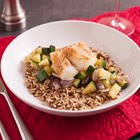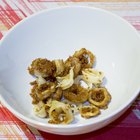bhofack2/iStock/GettyImages
Ahi tuna steaks have a mild flavor that isn’t overly fishy, so your family may welcome it over other kinds of fish. Because the steaks are a uniform thickness, they make it a snap for you to put a nutritious and delicious meal on your family’s table in no time, whether you prefer searing, grilling or broiling the tuna. To make it even more enjoyable, have your family help you put the meal together before cooking.
Flavoring Ideas
Ahi tuna is very flavorful and robust, and you and your kids may decide you like its natural flavor without any enhancement. However, if you want to change it a little, soy-sauce-based Asian marinades work well with ahi tuna steaks. For other options, experiment with premade marinades or salad dressing mixes that appeal to you. Use boldly flavored ones that will stand up to the strength of the tuna’s flavor, and choose low-sodium versions to keep your family’s sodium intake down. Keep the tuna in a marinade in your refrigerator for at least an hour before you plan to cook it. The longer it marinates, the more flavor the tuna absorbs.
Searing to Lock in Flavor
Ahi tuna steaks cook quickly and can dry out easily. To keep all those delicious juices inside your steaks, sear them in a pan on the stove. Heat a nonstick pan until it is very hot and use a little of your favorite vegetable or olive oil. Put a couple of seasoned steaks in the pan, and do not flip them until they have a nice brown crust on them. The amount of time needed will vary depending on the thickness of your tuna steaks, so watch them as you sear them. Sear them on the other side, then stick them in a low-temperature oven -- about 300 degrees Fahrenheit -- for five minutes to finish cooking. Properly cooked ahi tuna steaks will be just a little pink in the very middle. If your family prefers more well-done tuna steaks, cook them a minute or two longer. Don’t overcook, because the tuna can quickly dry out, even if you marinated it before cooking.
Grilling or Broiling
Preheat your grill on its highest setting, then put the tuna steaks onto the grill carefully with tongs. Rotate the steaks by a quarter turn of your wrist after about three minutes to get nice grill marks your family will admire. Flip the tuna steaks after another three minutes and repeat the process. Tuna steaks are done when they’re firm and just slightly pink in the center, but just like with searing them, cook them longer if your family prefers it. Broiling works similar to grilling, only you won’t be able to get nice grill marks on the steaks. Put a layer of aluminum foil on any pan you broil your tuna on for easy, quick cleanup after dinner.
Baking in Parchment Packets
Have your kids and other family members customize their tuna steaks by baking them in little parchment paper packets in the oven. Cut a big piece of parchment paper for each member of the family. Put a plate of tuna steaks in the middle of the table. Give your family choices of any thinly sliced vegetables, along with quick-cooking rice or noodles. Line up some marinades and salad dressing mixes on the table for them to use to flavor their individual dishes. Have them add no more than a cup of vegetables and 1/4 cup of quick-cooking rice or noodles to their parchment packets. Place the tuna steaks on top and add a little marinade. Instruct your family members to fold the parchment up over the top of the tuna, so it’s completely closed and nothing leaks out the sides. Staple the parchment packets shut, then put them on a baking sheet and bake at 350 degrees Fahrenheit for about 20 minutes. The liquid from the marinade and seasonings, combined with the juices of the tuna and vegetables, will gently steam the contents of each packet, and your kids will get to eat their tuna exactly how they like it.
Related Articles

How to Sear Two Inch Thick Wild Ahi Tuna

Substitutes for a Tuna Steak

How Do I Cook a Tuna Steak Without ...

How to Cook Sardine Fillets

How to Broil Salmon in Foil
Is There a Way to Cook Tuna Steaks on ...

How to Cook Tuna on a Stove
5 Simple Baked Salmon Recipes

Meals That Pair With Corn on the Cob
The Best Way to Cook a Pork Shoulder ...

How to Smoke Tuna

How to Make Tuna and Noodle Casserole

How to Cook Beef Tenderloin on a ...

How to Make Baked Haddock in a Foil ...

How to Cook Walleye by Broiling

How to Cook Axis Deer Steaks

How to Bake Cod

How to Make Oven-Broiled Marinated ...

How to Cook Calamari Steaks in a Frying ...

How to Grill Tuna Steak
References
Writer Bio
Amrita Chuasiriporn is a professional cook, baker and writer who has written for several online publications, including Chef's Blade, CraftyCrafty and others. Additionally, Chuasiriporn is a regular contributor to online automotive enthusiast publication CarEnvy.ca. Chuasiriporn holds an A.A.S. in culinary arts, as well as a B.A. in Spanish language and literature.